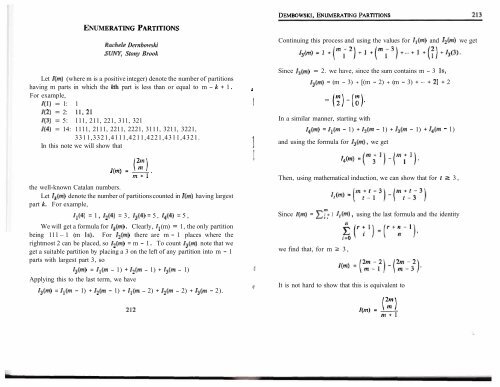must be odd, since n is odd and Tc{p) is even. Thus 4 1 E(p). Squaringboth sides of (b*) we obtainn 2 = V, ( E dor n 2 = 1 mod Q))corollary of Theorem 1:- Elf) + 1 (mod TUp-)for all p \ n. Our conclusion is the followingCOROLLARY 1: If n? V, then n 2 = 1 (mod H(p)) for all p 1 n.Using Property 1 of the Lucas period, we obtain similarly the followingcorollary of Theorem 2:COROLLARY 2: If n â V and n is q. f., then n2 = 1 (mod E(n)) .Unfortunately, the converse of either corollary is false. If n is1composite and if n- = 1 (mod E(p)j for all p \n, it is not necessarilytrue that n ? V. The counterexamples less than 500 are n = 15, <strong>10</strong>5, 161,195, 231, 323, 341, 377, 435, and 451; since all these are q. f. they arecounterexamples of either corollary.The hypothesis n 2 s 1 (mod Tc(p)) does imply the weaker conclusionL2 = 1 (modp)forallp In.If in addition we restrict n to be q. f. this implies only L2 = 1 (mod n).In conclusion, Theorem 2 could have some usefulness in testing forn â V, provided n is q. f. and its factorization is known. Until Conjecture1 is disposed of, we cannot completely characterize LPP's, but only q. f.LPP's. A priori, it might be the case that L,, = 1 (mod p) but Ln ?fe 1(mod p2) for some p with p2 \ n, so that n $ V.5. Filipponi, P., correspondence, <strong>No</strong>vember 1992.6. , correspondence, January 1993.7. Lagarias, J., correspondence, August 1993.8. Williams, H. C., A note on the Fibonacci quotient Fp .+, CanadianMathematical Bulletin 25 (1982). 366-370.Paul Bruckman received an M. S. degree in mathematics from theUniversity of Illinois at Chicago is 1974. He is a former pension planactuary and a frequent contributor to, and problem solver for, the <strong>Pi</strong> <strong>Mu</strong><strong>Epsilon</strong> Journal and the Fibonacci Quarterly.The Public Perception of MathematiciansMathematics is at the heart of the sciences. All of them requiremathematical formulas to express their various truths. As the saying goes,the physicists defer only to the mathematicians, and the mathematiciansdefer only to God. (Though one would be hard-pressed to find amathematician that modest.)-Dick Teresi, review of Science Matters by R. M. Hazen and JamesTrefil, New York Times Book Review, February 3, 1991, pp. 7, 9.References1. Bruckman, P. S., On the infinitude of Lucas pseudoprimes, FibonacciQuarterly 32 (1994) #2, 153- 154.2. , Lucas pseudoprimes are odd, Fibonacci Quarterly 32 ( 1994)#2, 155-157.3. , On a conjecture of DiPorto and Filipponi, FibonacciQuarterly, 32 (1994) #2, 158-159.4. , On square-free Lucas pseudoprimes, this Journal, 9 (1989-94)#9, 590-595.b
Rachele DernbowskiSUNY, Stony BrookLet I@) (where m is a positive integer) denote the number of partitionshaving m parts in which the kth part is less than or equal to m - k + 1 .1For example,/(I) = 1: 1l(2) = 2: 11,21l(3) = 5: 111, 211, 221, 311, 321l(4) = 14: 1111, 2111, 2211, 2221, 3111, 3211, 3221,3311,3321,4111,4211,4221,4311,4321.In this note we will show thatContinuing this process and using the values for Il(m) and 12(m) we getSince 13(m) = 2. we have, since the sum contains m - 3 Is,I3(m) = (m - 3) + [(m - 2) + (m - 3) + - + 21 + 2In a similar manner, starting with14(m) = ll(m - 1) + 12(m - 1) + 13(m - 1) + 14(m - 1)and using the formula for Ii(m), we getthe well-known Catalan numbers.Let Ik(m) denote the number of partitions counted in I(m) having largestpart k. For example,1](4) = 1 , li(4) = 3, 13(4) = 5, 14(4) = 5,We will get a formula for Ik(m) . Clearly, ll (m) = 1, the only partitionbeing 111 - 1 (m Is). For Ii(m) there are m - 1 places where therightmost 2 can be placed, so /->(m) = m - 1 . To count I3(m) note that weget a suitable partition by placing a 3 on the left of any partition into m - 1parts with largest part 3, so13(m) = Il(m - 1) + li(m - 1) + 13(m - 1)Applying this to the last term, we have13(m) = ll(m - 1) + b(m - 1) + ll(m - 2) + 12(m - 2) + 13(m - 2).Then, using mathematical induction, we can show that for t 2 3,Since f(m) = zrn I= I i,(m) , using the last formula and the identitywe find that, for m S 3,It is not hard to show that this is equivalent to
















